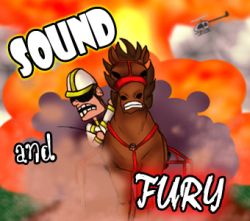Outside the Box: Sound and Fury
June 16, 2008,by Bob Carson
Editor’s Note: The USTA Web site is pleased to present freelance writer Bob Carson and his popular “Outside the Box” features. This monthly series is a menu of outlandish proposals presented with a wink — but the purpose behind them is serious.
“The human organism, as we know, is a machine on which excitations from without, streaming through the nerves and brain, effect internal work, and, notably, stimulate the glandular system.” — Havelock Ellis

Bob Carson
Should you decide to pitch a sports or entertainment product in today’s media marketplace, make sure to liberally attach words such as controversy, action, drama and conflict. These words get the attention of entertainment movers and shakers for a very simple reason — they sell. New media, or hypermedia, is based on brevity and spectacle. If an entertainment market waits for high quality and refined taste to sneak up and drive their product, they will be waiting a long time. Harness racing has waited too long.
The genesis of this new harness racing concept came as I perused the movie rental section at Blockbuster. Of the 10,000 potential rentals 9,968 films had the following themes woven into the alleged plots:
- Collisions
- Profanity
- Sex
- Very loud soundtracks
- Electrifying visual stimulation
The Masterpiece Theater crowd was out of luck. Mission Impossible IV, Die Hard VII, Terminator III, Miami Vice II and Chainsaw Massacre VIII fans were in luck. An entire section was devoted to Arnold and his cinematic tributes to good taste, subtleness, clever plotting, and the uplifting of the human spirit. Other popular sections featured classical actors such as Britney Spears, Pauley Shore, Puff Daddy, The Rock and Vin Diesel. Words such as demure, sedate, thoughtful or modest were not found on any promotional packaging. The store was doing a brisk business, although the Bronte, Shakespeare and Classics sections seemed to be a bit slow.

Autumn Schmidt graphic
In the modern entertainment world, even news and magazines, young producers are frightened to remain on any subject for more than five seconds without leaping to something else. In modern media, the trick is to click to another view before the viewer can tune you out. It’s a brutal war for the attention of the potential eyeball on your product. If you don’t agree, turn on the TV or slip in a movie; just watch how many times the camera jerks from shot to shot, how often and loudly the soundtrack nudges the viewer.
Perhaps a harness race lesson lies in the business models of Blockbuster and modern television — give people what they want. Here is a plan that will introduce loud noise, eye-popping visuals, collisions and profanity into the harness racing mix (sex, as usual, remains problematic). Three slight renovations need to be adopted at our local harness racetracks — spectacular sound systems, racecourse reconfigurations, and multiple cameras.
Sound: The most successful films have soundtracks that are set to a decibel level that will stun small animals. Collisions, explosions, glass breaking, tires screeching — all sounds must be magnified to a painful level in an effort to keep the patrons awake and nodding their heads in delight.
I have driven sulkies. The ride is quite loud and often quite profane. Occasionally, I thought the drivers around me were speaking in tongues or possessed by supernatural spirits. This is an asset that our sport needs to cash in on.
Microphones should be attached to drivers and horses. The live race sounds should be relayed to gigantic speakers at the racetrack and each television set. The sound level should be set to warp IV. Musical soundtracks with “cues” to ratchet up the railbirds’ excitement at various intervals should be tastefully overdubbed adding to the drama of the live race. The crescendo of music, stomping hoofs, shouting drivers, crashing seashores, screeching seagulls and soaring violin sections will blend together to make the Lethal Weapon VII sound man weep in jealousy.
The new sound system will not be a problem for traditionalists because 93.4 percent of them wear hearing aids (or should wear hearing aids) that can easily be turned down.
New Racetracks: The oval is out. One-directional racing is out. Similarly paced quarter-miles are out. Level surfaces are out. It’s a new day at the racetrack. Please study the carefully constructed diagram:

Notice several alterations to the traditional racetrack.
There are several opportunities for horses to collide. Audiences enjoy drama and crashes. Drivers may not. Remember, collisions, even near collisions, are not only visually stimulating, they are excellent fodder for our new sound system and have the peripheral value of profanity.
Astute viewers of harness racing may notice that the altered racetrack offers a startling array of opportunities for handicapping.
Speed will no longer be the sole factor in predicting the winner of a race. Horses with the ability to be steered, quickly reverse directions, leap over prostrate objects, brake quickly and read basic traffic signs will suddenly have their day in the sun.
The new racecourse configuration will virtually eliminate the drugging of horses. Milk shaking will be a thing of the past. Foreign substances in the equine system may induce vomiting and nausea before the third hairpin. The speed factor will be negated because the horses will need all of their faculties to compete successfully.
If you refer back to “ Figure B.” Sections X and J of the new racecourse will require elevation changes. Racetracks will have the option of varying the inclines, directions, distances and signage to give their course “individuality,” thereby eliminating the “boredom factor” of traditional racing.
Mount Cameras Everywhere and Switch Views Constantly: The final piece of the puzzle, as we attempt to stimulate the senses of the modern horse fan, will be a visual upgrade from watching horses racing via camera angles popular in 1947. Among the six thousand features that I will never use on my laptop computer is a camera about the size of a popcorn kernel. Cell phones use similar technology. We need to jump all over this.
This technology needs to be integrated into the visual presentation of our sport. The tiny cameras should be everywhere, the horse’s head, each driver’s helmet, in the paddock and in the barn. A visual presentation of a 2:00 horse race should have a minimum of 25 cuts to various views. Bettors or spectators will sit with the driver and have their senses flooded. The visual presentation, like the audio presentation should be powerful, dramatic, intrusive and manipulative.
In conclusion, the harness industry must hire some Silicon Valley gamer geeks and movie production crews to push our product to the front of the media line. Wire us up. Mike us up. Amp us up. Flash us up. We have an intrinsically interesting sports product in horse racing — better than most. Let’s get visual, dangerous and loud and let the race fans wager, watch and experience our sport in a way never imagined.
The benefits of our new sound system, multiple cameras and racecourse reconfiguration will give our sport a nice publicity jolt.
Shortly after the first pile-up and lawsuit, television and movies will suddenly find us much more attractive. Soon loud, classic, harness races will be shelved at Blockbuster. A new audience will dial up the volume and drop their jaws at the “bitchin” new sport on the block.
Watch out Arnold, “We’ll be back.”
